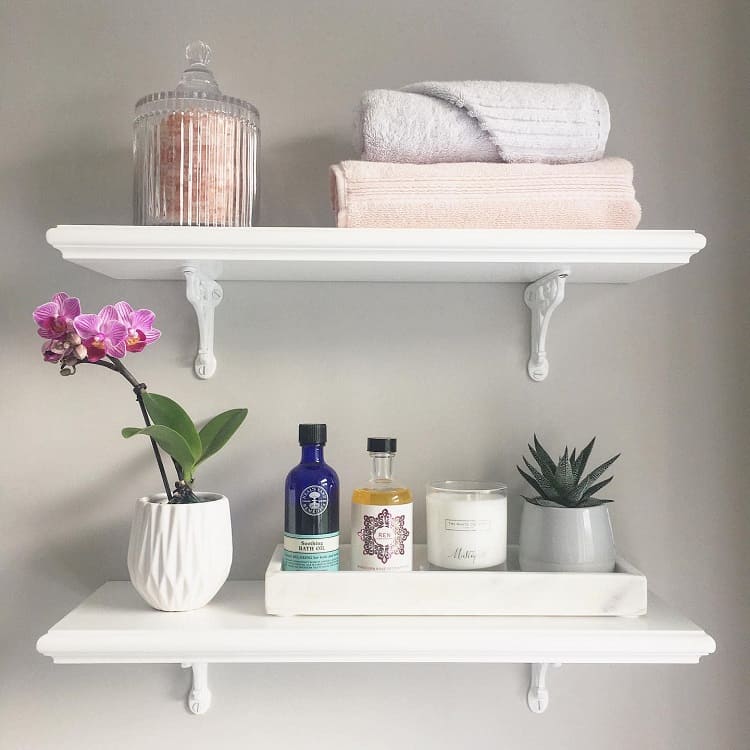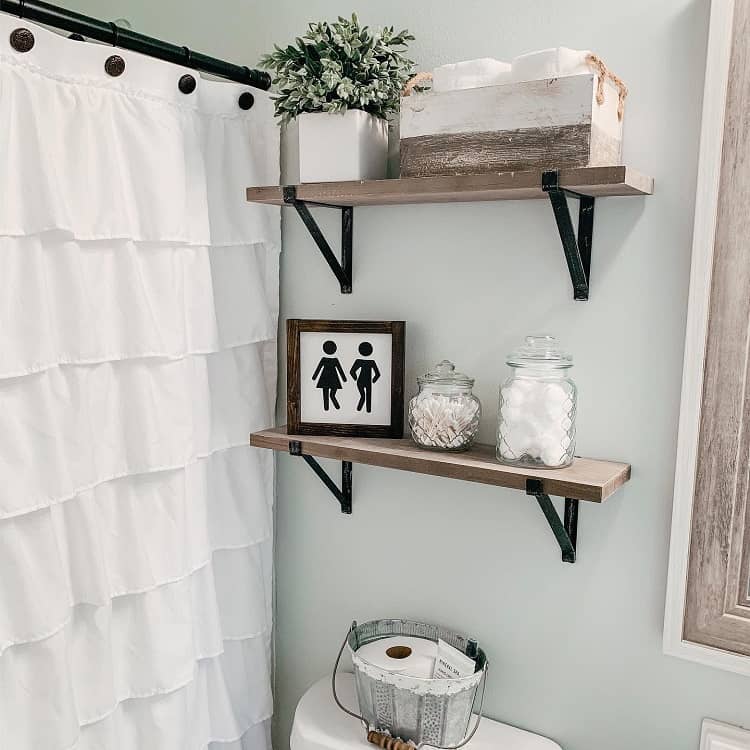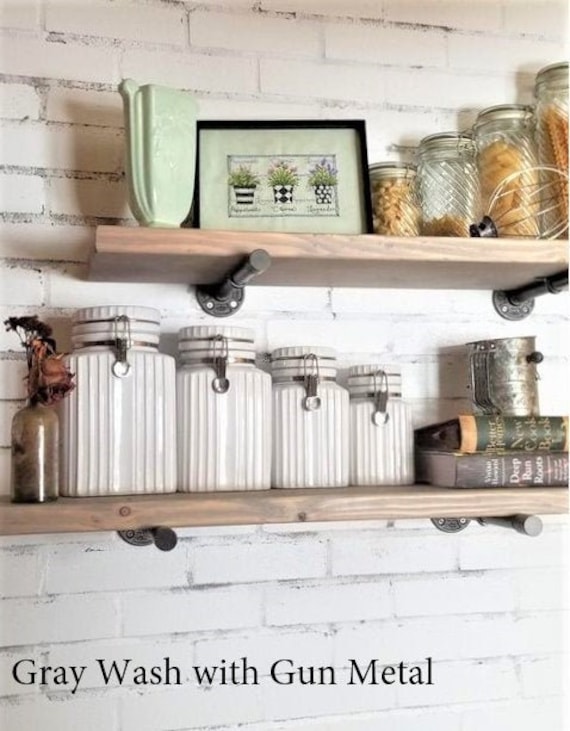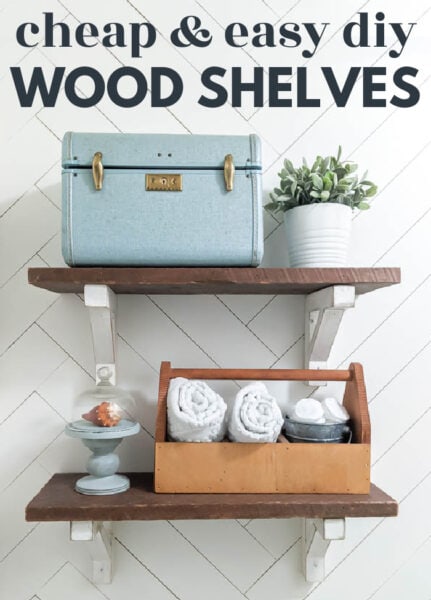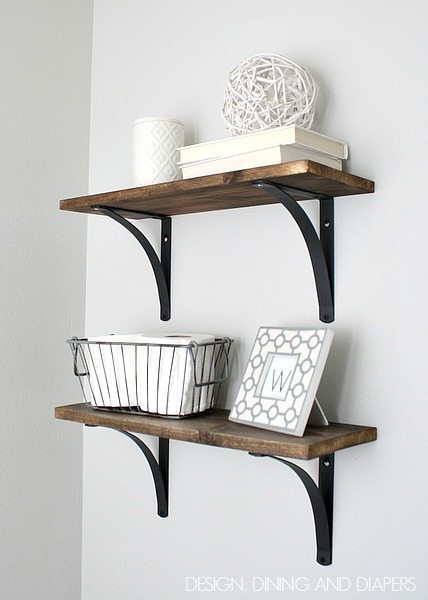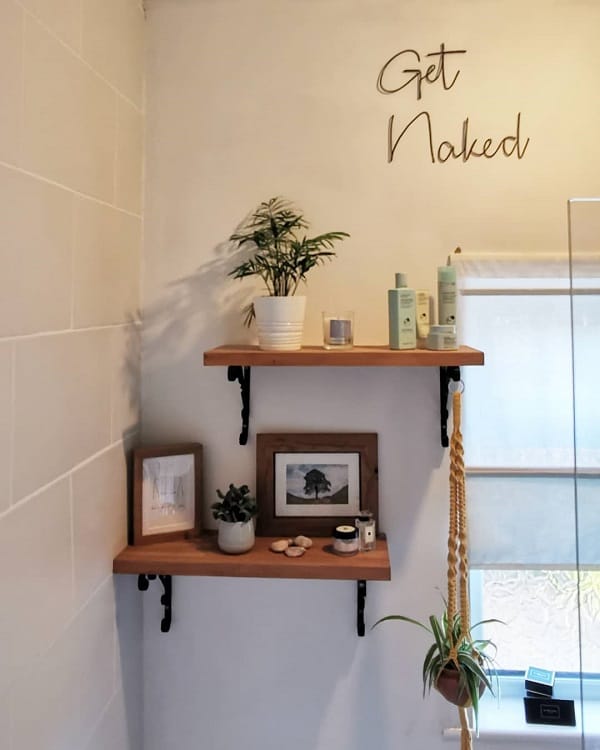Choosing the Right Bathroom Shelf
When it comes to choosing the right bathroom shelf, the options can seem overwhelming. There are countless materials, designs, and sizes to consider, each offering its unique advantages. The right choice will not only enhance the aesthetics of your bathroom but also provide the necessary functionality. Today I’ll walk you through the essential factors to consider when selecting the perfect bathroom shelf with brackets.
- Material Matters: The material of your bathroom shelf is crucial because it directly impacts the shelf’s durability, maintenance, and overall look. Common materials include wood, glass, metal, and plastic. Wood offers a warm and natural feel but requires regular maintenance to avoid water damage. Glass shelves are sleek and modern, perfect for a minimalist look, but they can be fragile and require frequent cleaning to keep them smudge-free. Metal shelves, especially those made of stainless steel or aluminum, are durable and resistant to rust, making them ideal for humid environments like bathrooms. Plastic shelves are budget-friendly and easy to clean, but they may not provide the same level of elegance as other materials.
- Design Aesthetics: The design of your bathroom shelf should complement the existing décor of your bathroom. If your bathroom has a rustic, farmhouse style, a wooden shelf with wrought iron brackets could be the perfect match. For a more contemporary or industrial look, a metal shelf with sleek, minimal brackets might be ideal. Glass shelves work well in modern bathrooms where clean lines and an open feel are desired. Don’t forget to consider the color and finish of the brackets—they should either blend seamlessly with your bathroom fixtures or stand out as a stylish accent.
- Size and Space Considerations: Before purchasing a bathroom shelf, it’s important to measure the available space. Consider the width, height, and depth of the shelf to ensure it fits comfortably in your bathroom without overwhelming the space. A narrow shelf might be perfect for a small bathroom or for holding just a few essentials, while a wider shelf can provide ample storage in larger bathrooms. Also, think about how much weight the shelf needs to support. Heavier items may require sturdier brackets and thicker shelving material.
- Functionality: The purpose of your bathroom shelf will also guide your choice. Are you looking for a shelf to hold toiletries and everyday essentials, or do you need it to display decorative items? Shelves with integrated towel bars or hooks can provide additional functionality. If you’re aiming to create a spa-like atmosphere, consider a shelf that can hold candles, plants, or rolled towels. For purely functional storage, focus on shelves that maximize space and are easy to access.
- Budget Considerations: Your budget will inevitably influence your choice of bathroom shelf. While it might be tempting to opt for the cheapest option, remember that quality and durability are important factors to consider. A well-made shelf with sturdy brackets might cost more upfront but can save you money in the long run by avoiding the need for replacements or repairs. On the other hand, if you’re on a tight budget, there are still plenty of affordable options that offer both style and function.
- Eco-Friendly Options: If environmental impact is a concern for you, consider opting for shelves made from sustainable or recycled materials. Bamboo shelves, for example, are a great eco-friendly option—they’re durable, water-resistant, and have a minimal carbon footprint. Recycled glass or metal shelves are also excellent choices if you’re looking to reduce your environmental impact. By choosing sustainable materials, you can create a beautiful bathroom space while also making a positive contribution to the planet.

How to Properly Mount a Bathroom Shelf with Brackets
Installing a bathroom shelf with brackets may seem daunting, but with the right tools and a little guidance, it’s a project you can confidently tackle on your own. Proper installation ensures that your shelf is secure and capable of holding whatever you place on it. In this step-by-step guide, I’ll walk you through the installation process, from gathering your materials to securing the final screws.
Gathering Your Tools and Materials: Before you begin, make sure you have all the necessary tools and materials. You’ll need a drill, a level, a tape measure, a pencil, wall anchors, screws, and, of course, your shelf and brackets. Depending on the material of your wall, you might need different types of wall anchors—plastic anchors for drywall or masonry anchors for brick or concrete walls. It’s also helpful to have a stud finder to locate the studs in your wall, as securing your shelf into a stud will provide extra stability.
Measuring and Marking: Once you have your tools ready, it’s time to decide where you want to place your shelf. Use your tape measure to determine the height at which you want the shelf to be mounted. Keep in mind the items you’ll be placing on the shelf and ensure there’s enough space above and below it. Hold the shelf up to the wall and use a pencil to mark where the brackets will go. This is where you’ll need the level—make sure the marks are even to ensure your shelf won’t be crooked once installed.
Drilling Holes: With your marks in place, it’s time to drill the holes for your brackets. If you’re securing the shelf into a stud, use a drill bit that’s slightly smaller than your screws to create pilot holes. If you’re not drilling into a stud, use the appropriate size drill bit for your wall anchors. Once the holes are drilled, insert the wall anchors by gently tapping them into the holes with a hammer. The anchors will help secure the screws and provide the necessary support for your shelf.
Attaching the Brackets: Now that your holes are ready, you can attach the brackets. Line the brackets up with the holes you’ve drilled, and use your drill to screw them into place. Make sure the brackets are securely fastened to the wall—they should not wiggle or move once installed. Double-check with your level to ensure the brackets are still even before proceeding to the next step.
Mounting the Shelf: With the brackets securely in place, you’re ready to mount the shelf. Depending on the design of your shelf, you may need to simply rest it on top of the brackets or screw it into place for extra security. If the shelf has pre-drilled holes, align them with the brackets and use screws to secure the shelf. Once the shelf is mounted, give it a gentle shake to make sure it’s firmly in place.
Final Adjustments: After the shelf is mounted, step back and take a look. Is it level? Does it feel secure? Make any necessary adjustments now before placing items on the shelf. Once you’re satisfied with the installation, you can start arranging your toiletries, décor, or whatever else you plan to store on your new shelf. Congratulations—you’ve successfully installed a bathroom shelf with brackets!
Maximizing Space: Creative Ways to Use a Bathroom Shelf with Brackets
Bathroom shelves with brackets are not just practical; they can also be incredibly versatile when it comes to maximizing space in your bathroom. Whether you have a small bathroom with limited storage or a larger space that could use some organization, there are plenty of creative ways to make the most of your bathroom shelf. In this section, I’ll share some ideas on how to use your shelf to its full potential.
Creating a Functional Vanity Area
One of the best ways to utilize a bathroom shelf is by transforming it into a mini vanity area. If you don’t have enough counter space, a shelf placed above or beside your sink can be the perfect spot for storing everyday essentials like toothbrushes, skincare products, and makeup. Add a small mirror above the shelf, and you’ve got a convenient vanity station without taking up too much space. To keep things tidy, consider using small trays or organizers to group similar items.
Showcasing Decorative Items for a Personal Touch
A bathroom shelf is also a great way to add a personal touch to your bathroom by displaying decorative items. Think about placing a few scented candles, small potted plants, or decorative jars filled with bath salts or cotton balls. You can even use the shelf to showcase a piece of art or a framed photo. The key is to strike a balance between functionality and aesthetics—don’t overcrowd the shelf, but don’t be afraid to add a few decorative elements that make the space feel more like home.
Storing Towels and Linens in a Stylish Way
If you’re short on closet space, a bathroom shelf can double as a storage area for towels and linens. Rolled towels not only look tidy but also add a spa-like feel to your bathroom. You can stack a few towels on the shelf, or place them in a stylish basket for a more organized look. Just make sure the shelf is sturdy enough to support the weight of the towels, especially if you’re storing more than a couple.
Organizing Toiletries for Easy Access
Another practical use for a bathroom shelf is to organize toiletries and other bathroom essentials. Install the shelf at a height that’s easy to reach, and use it to store items like shampoo, conditioner, body wash, and lotions. Clear containers or labeled jars can help keep everything organized and easily accessible. This is especially useful in smaller bathrooms where cabinet space is limited.
Creating a Relaxing Spa-Like Atmosphere
If you’re aiming to create a relaxing, spa-like atmosphere in your bathroom, your shelf can play a key role. Use it to display calming items like aromatherapy diffusers, bath oils, or a small stack of plush washcloths. Consider placing a small speaker on the shelf to play soothing music during your bath. The goal is to create a serene and peaceful environment that makes you feel pampered every time you step into your bathroom.
Adding Extra Storage for Cleaning Supplies
Lastly, your bathroom shelf can also serve as additional storage for cleaning supplies. If you don’t have a lot of under-sink space, a shelf can be a great place to keep items like toilet cleaner, disinfectant spray, and extra sponges. Just be sure to keep these items out of reach if you have children or pets. By utilizing your shelf for cleaning supplies, you can keep your bathroom tidy and organized without cluttering up valuable storage space elsewhere.
Stylish and Functional: Integrating Bathroom Shelves into Your Décor
Integrating bathroom shelves into your décor doesn’t just add functionality—it can also enhance the overall style of your space. With the right design choices, a bathroom shelf can become a key feature that ties the room together. Whether you’re working with a minimalist, rustic, or modern aesthetic, I’ll guide you through some creative ways to incorporate shelves into your bathroom décor.
Complementing Your Bathroom’s Color Scheme
One of the first things to consider when adding a bathroom shelf is how it will complement your existing color scheme. If your bathroom has a neutral palette, consider a shelf in a complementary material like natural wood or sleek metal to add warmth or contrast. For a bolder look, you can choose a shelf in a striking color that contrasts with the walls or tiles. The key is to ensure that the shelf either blends seamlessly with the rest of the bathroom or stands out as a deliberate design choice.
Mixing and Matching Materials for a Cohesive Look
Mixing materials can add depth and interest to your bathroom décor. For example, if your bathroom features a lot of glass and metal, a wooden shelf can introduce a natural element that softens the space. Conversely, in a bathroom with a lot of natural elements, a glass or metal shelf can add a touch of modernity. When choosing materials, think about how the shelf will interact with other fixtures like the sink, mirror, and lighting. The goal is to create a cohesive look that feels intentional and well-thought-out.
Creating Visual Interest with Shelf Placement
The placement of your bathroom shelf can also contribute to the overall aesthetic. Instead of the usual horizontal shelf, consider installing a series of staggered shelves at different heights to create visual interest. This can be especially effective in a larger bathroom where you have more wall space to work with. Alternatively, installing a shelf in an unexpected spot, like above the door or next to the bathtub, can add an element of surprise and make the room feel more dynamic.
Accessorizing Thoughtfully for Style and Function
Once your shelf is installed, it’s time to accessorize. The items you place on the shelf can greatly impact the overall look and feel of your bathroom. For a minimalist bathroom, keep accessories simple and functional—a small plant, a couple of neatly folded towels, and a bottle of lotion might be all you need. In a more eclectic bathroom, you can mix and match different items like decorative bottles, vintage jars, and small art pieces. The key is to balance style with function—your shelf should be both beautiful and useful.
Incorporating Lighting for a Dramatic Effect
Lighting can play a big role in how your bathroom shelf looks and feels. If possible, consider adding a small light fixture above or below the shelf to highlight your accessories and create a warm, inviting glow. LED strip lights are a popular choice for this purpose—they’re easy to install and can be cut to fit the length of the shelf. Lighting not only enhances the aesthetics but also makes it easier to find items on the shelf, especially in the evening or early morning.
Customizing Shelves for a Personal Touch
Finally, don’t be afraid to get creative and customize your shelves to reflect your personal style. You could paint the shelf or brackets in a custom color, add decorative trim, or even stencil a design onto the shelf surface. Customizing your shelves allows you to create a truly unique piece that stands out in your bathroom. Whether you go for a subtle change or a bold statement, customization can turn a simple shelf into a standout feature.
Maintenance Tips: Keeping Your Bathroom Shelf Clean and Sturdy
Once you’ve installed your bathroom shelf, it’s important to maintain it properly to ensure it stays clean and sturdy over time. Regular maintenance not only prolongs the life of your shelf but also keeps your bathroom looking neat and tidy. Let me share some practical tips on how to care for your bathroom shelf and keep it in top condition.
Regular Cleaning: Keeping Your Shelf Spotless
Cleaning your bathroom shelf regularly is essential, especially in a humid environment where mold and mildew can easily develop. For wooden shelves, use a damp cloth to wipe away dust and grime, and avoid harsh chemicals that could damage the finish. Glass shelves should be cleaned with a glass cleaner and a microfiber cloth to prevent streaks. Metal shelves can be wiped down with a damp cloth and dried thoroughly to prevent rust. Regular cleaning not only keeps your shelf looking good but also prevents the buildup of dirt and bacteria.
Checking for Loose Brackets: Ensuring Stability
Over time, the brackets that hold your shelf in place can become loose, especially if the shelf is holding heavy items. It’s a good idea to periodically check the brackets and tighten any screws that may have come loose. If you notice that the shelf is wobbling or doesn’t feel as sturdy as it used to, it might be time to re-secure the brackets or even move the shelf to a different location if the wall anchors have become loose.
Preventing Water Damage: Protecting Wooden Shelves
If you have a wooden shelf in your bathroom, water damage is a potential concern. To prevent this, make sure to wipe up any spills or water droplets as soon as possible. You can also apply a water-resistant sealant to the shelf to provide an extra layer of protection. Avoid placing wet items directly on the shelf, as this can cause the wood to warp or develop mold over time. Instead, use trays or mats to hold items like soap dispensers or cups.
Avoiding Overloading: Knowing Your Shelf’s Weight Limit
It’s important to be mindful of how much weight you’re placing on your bathroom shelf. Overloading the shelf can cause it to sag or even pull away from the wall. Check the manufacturer’s guidelines for the recommended weight limit, and distribute items evenly across the shelf to avoid putting too much pressure on one side. If you need to store heavy items, consider installing additional brackets or opting for a more durable shelf material like metal or tempered glass.
Addressing Rust and Corrosion: Maintaining Metal Shelves
Metal shelves and brackets are prone to rust and corrosion, especially in a humid bathroom environment. To prevent this, make sure to dry metal surfaces thoroughly after cleaning and avoid using harsh chemicals that could strip away the protective coating. If you do notice rust forming, you can remove it with a mixture of baking soda and water, applied with a soft cloth. For more stubborn rust, a rust remover specifically designed for metal surfaces can be used.
Seasonal Maintenance: Keeping Your Shelf in Top Shape
Just like any other part of your home, your bathroom shelf can benefit from seasonal maintenance. Every few months, take the time to give the shelf a thorough cleaning, check for any signs of wear and tear, and make any necessary repairs. This is also a good time to reorganize the items on the shelf—get rid of anything you no longer need and make sure everything is neatly arranged. Regular seasonal maintenance ensures that your bathroom shelf remains a functional and attractive part of your space for years to come.
Common Mistakes to Avoid When Installing a Bathroom Shelf with Brackets
Installing a bathroom shelf with brackets might seem straightforward, but several common mistakes can lead to frustration, instability, or even damage to your walls. Avoiding these pitfalls is key to a successful installation that’s both sturdy and aesthetically pleasing. In this section, I’ll highlight some of the most common mistakes people make when installing bathroom shelves and how to avoid them.
Skipping the Stud Finder: Why Locating Wall Studs Is Crucial
One of the most common mistakes when installing a bathroom shelf is skipping the step of locating wall studs. Attaching the brackets directly into drywall without securing them to a stud can result in a weak installation that won’t hold up over time. Even if you’re using wall anchors, securing at least one bracket into a stud provides much-needed support, especially for heavier shelves or those holding heavy items. Always take the time to use a stud finder to locate the studs before you start drilling.
Using the Wrong Wall Anchors: Choosing the Right Type for Your Walls
Not all wall anchors are created equal, and using the wrong type can lead to instability. For drywall, plastic wall anchors are typically sufficient for lighter loads, but for heavier shelves or for installation in plaster or concrete walls, you’ll need more robust anchors like toggle bolts or masonry anchors. Failing to use the appropriate anchors can cause the shelf to sag, become loose, or even fall off the wall. Make sure to choose the right anchors based on the material of your walls and the weight of the items you plan to store.
Neglecting to Measure Properly: Ensuring Even and Level Installation
Another common mistake is not taking accurate measurements before drilling. Uneven or misaligned brackets can result in a crooked shelf, which not only looks bad but can also cause items to slide off. Always measure and mark the placement of your brackets carefully, using a level to ensure they are even. Double-check your measurements before drilling any holes—this extra step can save you from having to redo the entire installation.
Overloading the Shelf: Understanding Weight Limits
It’s easy to underestimate how much weight a shelf can hold, but overloading it can lead to serious problems. Exceeding the weight limit of the shelf or brackets can cause the shelf to bow, the brackets to pull away from the wall, or even the entire shelf to come crashing down. To avoid this, always check the manufacturer’s recommended weight limit and distribute weight evenly across the shelf. If you’re unsure, err on the side of caution and avoid placing too many heavy items on the shelf.
Ignoring the Shelf Material: Considering the Effects of Humidity
Bathrooms are naturally humid environments, and not all shelf materials are suited to these conditions. Installing a wooden shelf without proper treatment or finishing can lead to warping, swelling, or mold growth over time. Glass shelves can be a good alternative for humid areas, but they can be slippery if not properly secured. Metal shelves need to be rust-resistant to avoid corrosion. When choosing a shelf, consider the material’s durability and how it will hold up in a moist environment.
Failing to Plan for Accessibility: Considering Daily Use
Lastly, it’s important to consider how you’ll be using the shelf daily. Installing it too high or too low can make it difficult to access, rendering it less functional. Think about who will be using the shelf and what items will be stored on it. If the shelf is meant to hold everyday essentials, make sure it’s installed at a comfortable height that’s easy to reach. Planning for accessibility ensures that your bathroom shelf is not only stylish but also practical and convenient for daily use.
Frequently Asked Questions
When it comes to installing and maintaining bathroom shelves with brackets, you might have a few questions in mind. Whether you’re a DIY novice or an experienced home improver, it’s always helpful to get clear answers before starting a project. In this section, I’ll address some of the most frequently asked questions about bathroom shelves with brackets to help you make informed decisions.
What is the Best Material for a Bathroom Shelf?
Choosing the best material for your bathroom shelf depends on your specific needs and the conditions of your bathroom. If you’re looking for something durable and resistant to moisture, metal and glass are excellent choices. Metal shelves, especially those made of stainless steel or aluminum, are resistant to rust and corrosion, making them ideal for humid environments. Glass shelves are sleek and easy to clean, but they can be fragile. Wood can add a warm, natural look to your bathroom, but it requires proper sealing and regular maintenance to prevent water damage. For those on a budget, plastic shelves are lightweight and easy to maintain, though they may not offer the same aesthetic appeal as other materials.
How High Should I Install My Bathroom Shelf?
The ideal height for installing a bathroom shelf depends on its purpose and the height of the users. For a shelf above the sink, a good rule of thumb is to install it about 5 to 6 feet from the floor, depending on the height of your family members. If the shelf is meant to hold toiletries or other daily essentials, it should be easily accessible without the need for stretching or bending. For decorative shelves, you have more flexibility with height, but it’s still important to consider the overall balance and proportions of the room.
Can I Install a Bathroom Shelf Without Drilling?
Yes, it is possible to install a bathroom shelf without drilling, especially if you’re renting or want to avoid damaging your walls. There are adhesive shelves available that use strong, waterproof adhesives to stay in place. However, these shelves are typically best for lighter items and may not offer the same stability as drilled shelves. If you opt for an adhesive shelf, make sure to follow the manufacturer’s instructions carefully and avoid placing heavy items on it. Another option is using tension rods or brackets that grip onto the walls, though these may not be as sturdy as drilled installations.
How Do I Prevent My Bathroom Shelf from Rusting?
If you have a metal bathroom shelf, rust prevention is key to maintaining its appearance and functionality. To prevent rust, choose shelves made of rust-resistant materials like stainless steel or aluminum. Regularly wiping down the shelf to remove moisture can also help prevent rust formation. If you notice any rust spots, remove them promptly with a rust remover or a mixture of baking soda and water. Applying a coat of clear sealant or rust-resistant paint can also provide an additional layer of protection against moisture and rust.
How Much Weight Can My Bathroom Shelf Hold?
The weight capacity of your bathroom shelf depends on several factors, including the material of the shelf, the type of brackets used, and how the shelf is mounted. Most bathroom shelves can hold between 20 to 50 pounds, but it’s important to check the manufacturer’s specifications for your particular shelf. If you’re storing heavy items like large bottles or multiple towels, consider using additional brackets for extra support. Distributing the weight evenly across the shelf can also help prevent sagging or instability.
Can I Customize My Bathroom Shelf?
Absolutely! Customizing your bathroom shelf is a great way to add a personal touch to your space. You can paint or stain wooden shelves to match your bathroom’s color scheme, or add decorative trim to make the shelf stand out. For a more unique look, consider using unconventional materials for the shelf itself, like repurposed wood or reclaimed metal. Customizing the brackets is another option—swap out standard brackets for decorative ones that match your bathroom’s style. The possibilities for customization are endless, allowing you to create a shelf that’s both functional and uniquely yours.
Bathroom Shelf Ideas – Interior Home and Design
Gray Floating Shelf Shelf Shelves Shelf Brackets Farmhouse
How to Make Cheap and Easy DIY Shelf Brackets
Reclaimed Wood Bathroom Shelves With 6 Handmade
Rustic DIY Bathroom Shelving – Taryn Whiteaker Designs
Best Bathroom Shelf Ideas – Interior Home and Design
Related Posts:
- Bathroom Organizer Wall Shelf Stainless Steel
- Best Adhesive Bathroom Shelf
- Narrow Bathroom Shelf Ideas
- Domax Bamboo Bathroom Shelf
- The Range Bathroom Shelves
- Glass And Metal Bathroom Shelves
- Rotating Shelf Bathroom Organizer Rack
- Bathroom Shelf Corner Brackets
- Bathroom Shelves Over Toilet Chrome
- Tier Shelf Bathroom Organizer

